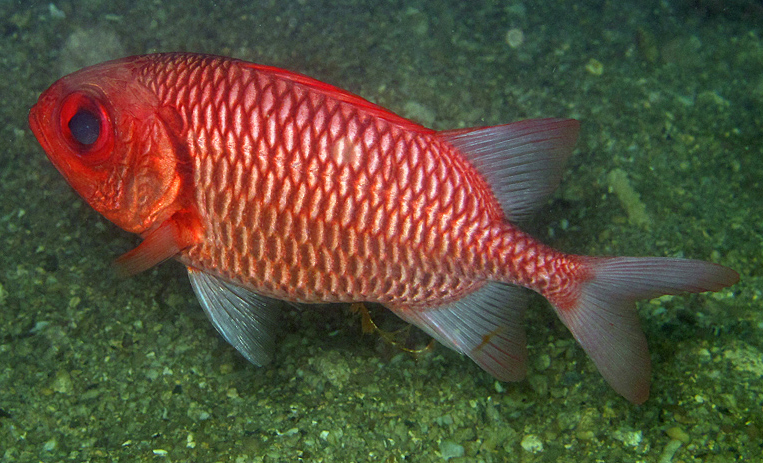Doubletooth Soldierfish, Myripristis hexagona (Lacépède 1802)
Other Names: Red-fin Squirrelfish

A Doubletooth Soldierfish, Myripristis hexagona, at Magnetic Island, Queensland. Source: Andy A. Lewis / Lizard Island Research Station. License: CC by Attribution-NonCommercial-ShareAlike
Summary:
A light red to yellowish squirrelfish with red fins and white leading edges on the soft dorsal, anal, caudal and pelvic fins.
Cite this page as:
Bray, D.J. 2022, Myripristis hexagona in Fishes of Australia, accessed 27 Jun 2025, https://fishesofaustralia.net.au/Home/species/4440
Doubletooth Soldierfish, Myripristis hexagona (Lacépède 1802)
More Info
|
Distribution |
Shark Bay and Rowley Shoals, Western Australia, to Byron Bay, New South Wales. Elsewhere the species is widespread in the tropical, Indo-west Pacific. Inhabits sheltered coastal and offshore reefs, often in turbid areas, hiding in caves and beneath ledges during the day. |
|
Feeding |
Feeds on plankton such as crab larvae at night. |
|
Etymology |
[stated to resemble an elongate hexagon, implying a noun, with derivation possibly from the Greek hexa = six + gonia = corner or angle; alternately Latinization of the French hexagone, again a noun] |
|
Species Citation |
Lutjanus hexagonus Lacépède 1802, Histoire Naturelle des Poissons Vol. 4: 213. Type locality unknown. |
|
Author |
Bray, D.J. 2022 |
|
Resources |
Doubletooth Soldierfish, Myripristis hexagona (Lacépède 1802)
References
Allen, G.R. 1997. Marine Fishes of Tropical Australia and South-east Asia. Perth : Western Australian Museum 292 pp. 106 pls.
Allen, G.R. & Erdmann, M.V. 2012. Reef fishes of the East Indies. Perth : Tropical Reef Research 3 vols, 1260 pp.
Allen, G.R. & Swainston, R. 1988. The Marine Fishes of North-Western Australia. A field guide for anglers and divers. Perth, WA : Western Australian Museum vi 201 pp., 70 pls. (as Myripristis hexagonatus)
Hutchins, J.B. 2003. Checklist of marine fishes of the Dampier Archipelago, Western Australia. pp. 453-478 in Wells, F.E., Walker, D.I., & Jones, D.S. (eds). Proceedings of the Eleventh International Marine Biological Workshop: The Marine Flora and Fauna of Dampier, Western Australia. Perth : Western Australian Museum.
Kuiter, R.H. 1992. Tropical Reef-Fishes of the Western Pacific, Indonesia and Adjacent Waters. Jakarta : PT Gramedia Pustaka Utama 314 pp. pls.
Lacépède, B.G. 1802. Histoire Naturelle des Poissons. Paris : chez Plassan Vol. 4 728 pp. 16 pls. See ref at BHL
Larson, H.K., Williams, R.S. & Hammer, M.P. 2013. An annotated checklist of the fishes of the Northern Territory, Australia. Zootaxa 3696(1): 1-293
Ogilby, J.D. 1908. New or little known fishes in the Queensland Museum. Annals of the Queensland Museum 9(1): 3-41 (described as Ostichthys spiniceps, type locality Great Barrier Reef)
Randall, J.E. 2005. Reef and shore fishes of the South Pacific. New Caledonia to Tahiti and the Pitcairn Islands. Honolulu : University of Hawaii Press 707 pp.
Randall, J.E., Allen, G.R. & Steene, R. 1990. Fishes of the Great Barrier Reef and Coral Sea. Bathurst : Crawford House Press 507 pp. figs.
Randall, J.E., Allen, G.R. & Steene, R. 1997. Fishes of the Great Barrier Reef and Coral Sea. Bathurst : Crawford House Press 557 pp. figs.
Randall, J.E. & Greenfield, D.W. 1996. Revision of the Indo-Pacific holocentrid fishes of the genus Myripristis, with descriptions of three new species. Indo-Pacific Fishes 25: 1-61 figs 1-12 pls 1-9
Randall, J.E. & Greenfield, D.W. 1999. Family Holocentridae. pp. 2225-2256 in Carpenter, K.E. & Niem, T.H. (eds). The Living Marine Resources of the Western Central Pacific. FAO Species Identification Guide for Fisheries Purposes. Rome : FAO Vol. 4 pp. 2069-2790.
Taylor, W.R. 1964. Fishes of Arnhem Land. Records of the American-Australian Scientific Expedition to Arnhem Land 4: 44-307 figs 1-68
Williams, I. & Greenfield, D. 2016. Myripristis hexagona (errata version published in 2017). The IUCN Red List of Threatened Species 2016: e.T67870015A115435358. https://dx.doi.org/10.2305/IUCN.UK.2016-1.RLTS.T67870015A67871825.en. Accessed on 24 June 2022.




